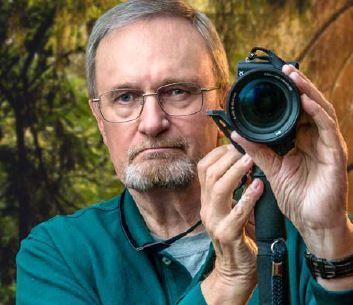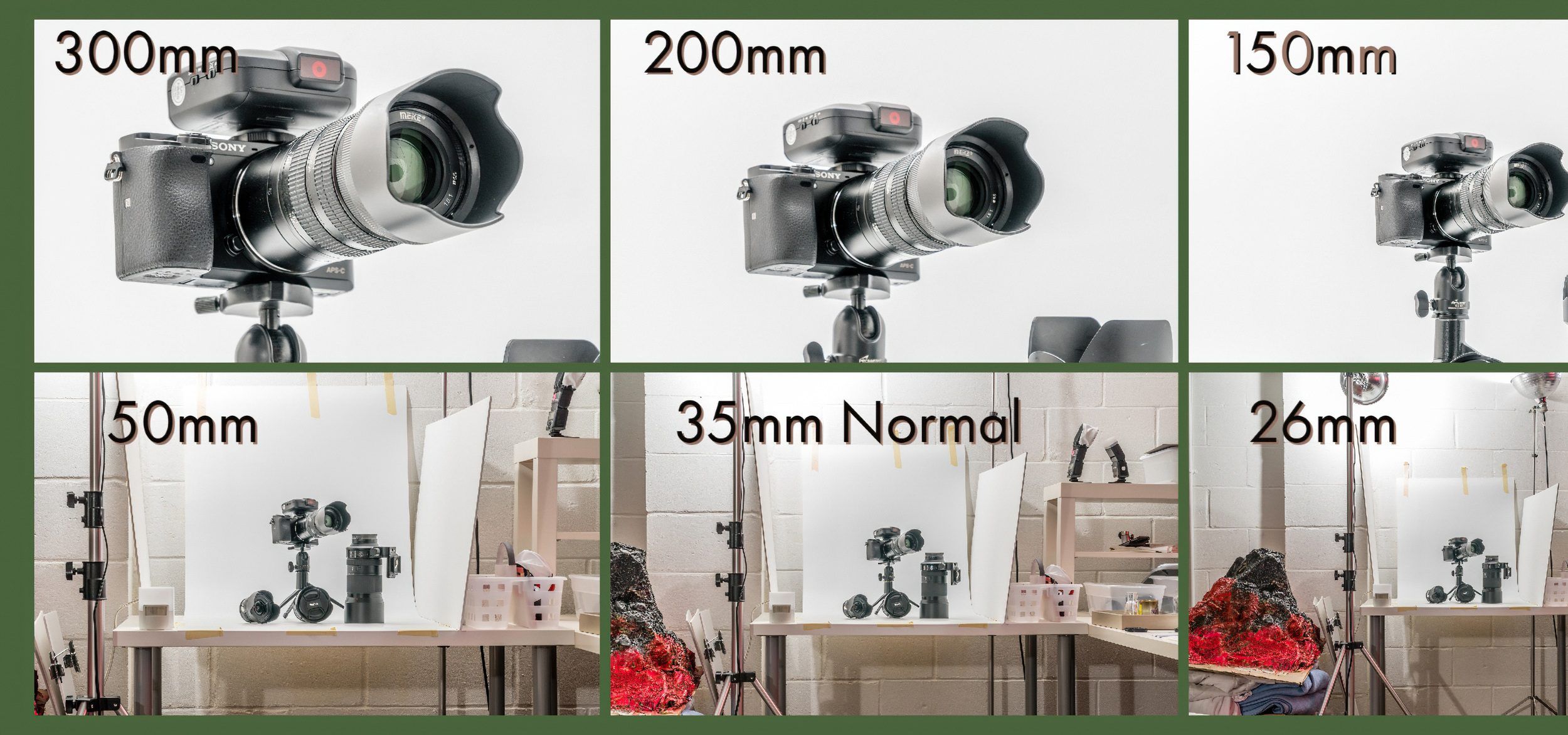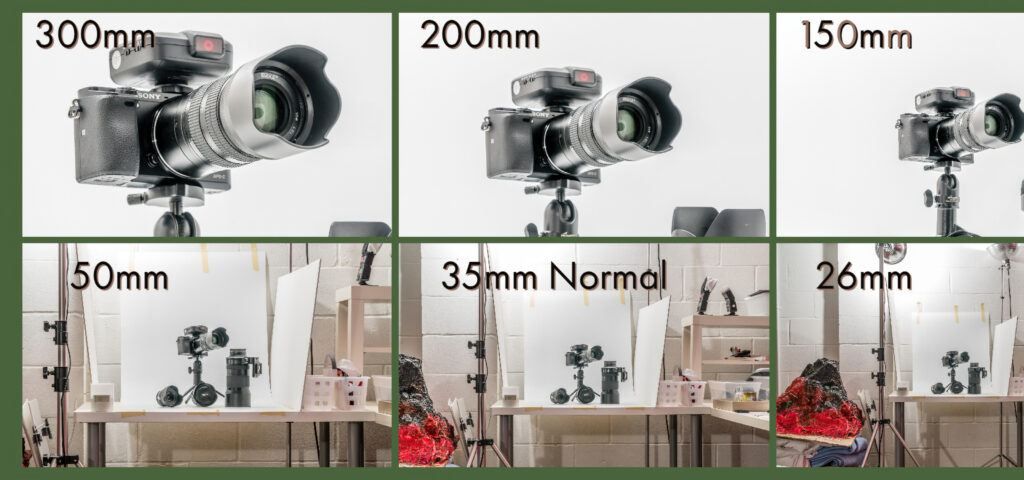When I was in school back in the paleophotographic (Yes, I made that up.), the first thing we learned about was optics—lenses—and different focal lengths of various lenses. We would spend the rest of our photographic careers choosing lenses based on their focal lengths, so we needed to know what focal length was and how it worked. Did we want a very broad angle of view, taking in a lot of the scene? Or did we need to make something appear bigger without moving the camera? We had to understand focal length to choose the right one to get the picture we wanted.
What effect does the choice of focal length have on the image? Why does it matter? Many cameras once came already fitted with something called a “normal” lens, but what is “normal”? The focal lengths of so-called “normal” lenses seem to be all over the place. Why?
All lenses have a focal length, even simple lenses such as those found in magnifying glasses. Concave and convex mirrors have a focal length. Some lenses, called “zooms,” have multiple focal lengths. What exactly does “focal length” mean? What is it? And why, as a photographer, should I care?
Focal length is not really all that mysterious. Excerpting from the Wikipedia article, “…the focal length of an optical system is a measure of how strongly the system converges or diverges light; it is the inverse of the system’s optical power. In photography, longer focal length leads to higher magnification and a narrower angle of view; conversely, shorter focal length or higher optical power is associated with lower magnification and a wider angle of view.”
Key Lesson: The focal length of an optical system is a measure of how strongly the system converges or diverges light.
Recommended Reading: If you’d like to master camera settings to create gorgeous, creamy, blurry backgrounds, grab a copy of Photzy’s premium guide: Beautiful Background Blur.
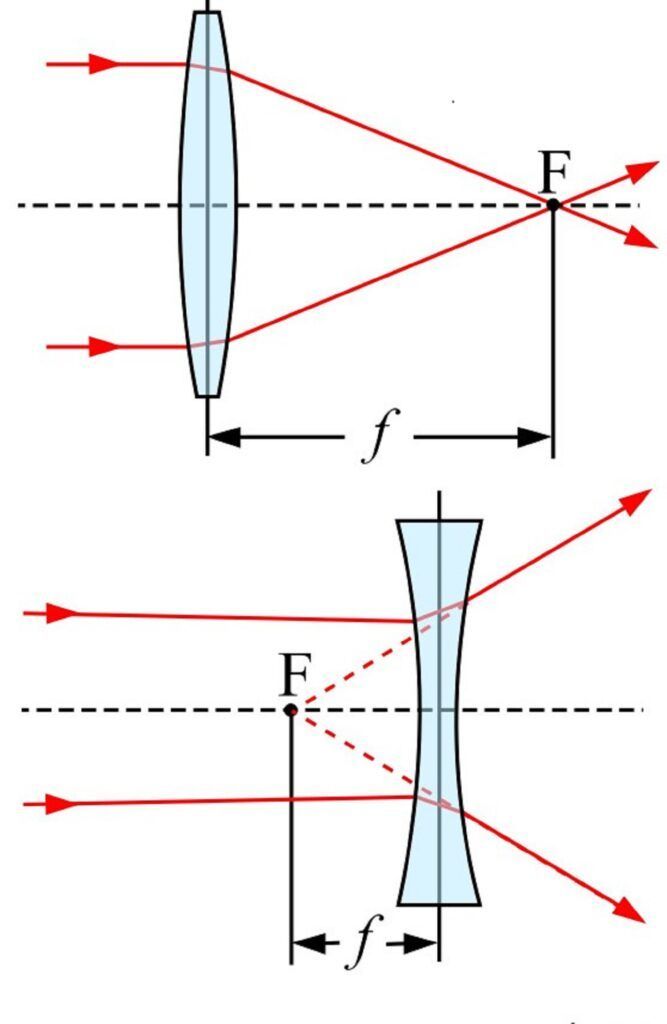
The focus F and the focal length f of a positive lens and a negative lens. Diagram by Henrik
Here are diagrams of simple lenses. One shows a positive, converging so that it bends light to a focus at point F, and the other diverging, which is a negative lens.
Key Lesson: All lenses have a focal length, from simple single lenses to computer-designed and engineered lenses.
Lenses for photography often have within the lens barrel both converging and diverging elements to bring all colors of light to a sharp focus at the focal plane, your sensor, or film. Modern lenses are complexly formulated to correct as many aberrations (flaws) as they can.
In this article, we’ll learn about the following:
- Does “focal length” refer to the physical length of the lens?
- The practical effect of focal length on magnification
- What “normal” focal length is and why it varies from format to format
- What is an Equivalent focal length?
- What wide-angle lenses are
- What telephoto lenses are
- Why you choose a certain focal length
- Does focal length affect perspective?
- Does focal length affect the depth of field?
All any camera is a light-tight box with a lens on one end and a photosensitive material on the other. We think now in digital terms much more than film (analog), but it’s all fundamentally the same. A lens brings an image of an object to a sharp focus at the focal plane, where a film or sensor records the image.

No camera is of any use without some sort of a lens, at least a pinhole. The lens bends the light rays to focus them at the focal plane so the projected image can be recorded. Illustration by Charles Haacker
Simple cameras may have simple, fixed focus “prime” lenses, better than a pinhole. Your cell phone has an astounding computer of a camera, but many still have a fixed prime lens (single focal length). When most phones “zoom,” they are not changing the actual focal length like a varifocal but are rather enlarging the image at the focal plane, sometimes called “digital zoom.” Computational photography has considerably improved “digital zoom,” but it is not as good as optical zoom because all you are doing is enlarging pixels, and there is a limit to how far you can go before all you can see are pixels and the image becomes mush.
Key Lesson: Optical zoom and digital zoom are not the same things. Optical zoom is superior.
For maximum quality, we want to be able to change the physical focal length, either with a good zoom or varifocal, fixed or not (think little compacts), or if interchangeable we have the option of choosing “primes” (lenses of one focal length) or zooms. Many of us use both.
Does the Physical Length of the Lens Affect Focal Length?
Yes. No. Maybe… Sometimes.
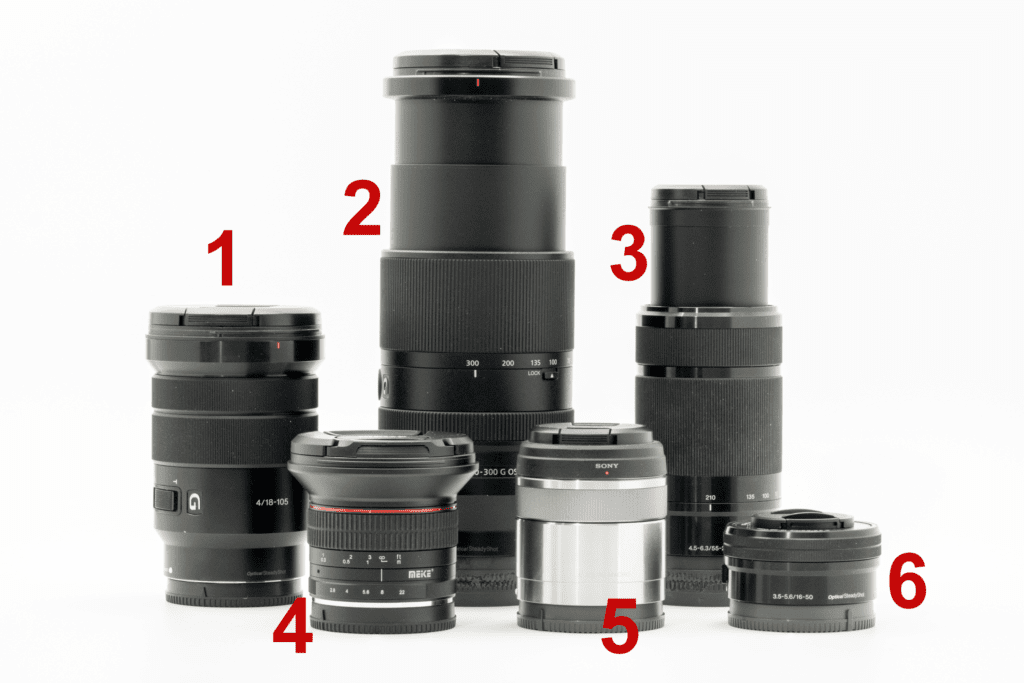
Photograph by Charles Haacker
These are the lenses I use the most. Notice the wide range of physical lengths. Two are primes, two are “true” zooms, and two are varifocals. They range from 12mm (18mm full-frame equivalent) to 300mm (450mm full-frame). For the sorts of photography that I do, this is an excellent range. Number five is a 30mm, normal prime, dedicated macro. It’s a super-useful lens that focuses from 1:1 (100% at the focal plane) to infinity without changing the lens or needing any accessory like an extension tube or reversing ring. I can and do go out with only that lens on my camera, shooting anything and everything. Having only one fixed focal length is a limitation, but it’s also a creative challenge.
- Sony E PZ 18–105mm f/4 G OSS (27–158 equivalent), my go-to varifocal (internal zoom). This single lens I use for probably 65% of my shots.
- Sony FE 70-300mm f/4.5–5.6 G OSS Lens (105–450 equivalent) TRUE zoom (length changes). When on assignment I have this lens on one body and my 18—105 on the other.
- “Kit” Sony E 55–210mm f/4.5–6.3 OSS, TRUE zoom (physical length changes). Less than half the mass of the 70-300 but also slower. I use it when I want to work light.
- MeiKe 12mm f/2.8 prime wide-angle, manual only, equivalent to 18mm full-frame. My widest angle lens.
- Sony 30mm f/3.5 E-mount Macro Prime Lens (45mm equivalent). Doubles as a normal lens
- “Kit” Sony 16–50mm f/3.5-5.6 OSS Retractable Zoom Lens “Pancake” varifocal (internal zoom). This unfairly disparaged lens weighs only 3.2 ounces and retracts into its own tube. Only a 3X zoom but a featherweight, inconspicuous powerhouse.
- NOT SHOWN (because it took these pictures)—MeiKe 85mm f/2.8 Macro lens, manual only, overall standout general purpose lens, focuses from infinity to 1.5X. So sharp you have to be careful not to cut yourself. (Kidding.)
Key Lesson: The physical measurements of a lens do not necessarily tell you its focal length.
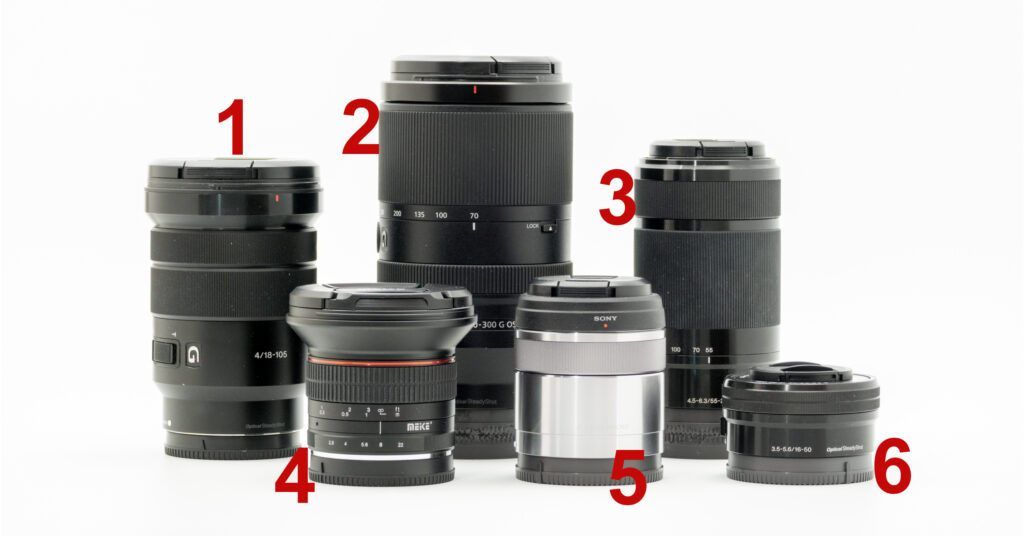
Photograph by Charles Haacker
This illustration gives a hint of the difference between varifocals and so-called “true” zooms. See how the two big zooms, 2 and 3, are now shorter? Those are the so-called “true” zooms; they change their physical length with their focal length. The other two, 1 and 6, are varifocal lenses that do all their zooming internally. Their physical length does not change when the focal length changes. The practical difference is negligible. Photo-nerds just like to know this stuff.
What Is the Practical Effect of Focal Length on Magnification?

Photograph by Charles Haacker
“Long, telephoto” lenses bring far things nearer, like telescopes. “Normal” lenses see things about as your eyes do. “Short” WA lenses have a wider angle of view to take in more of the peripheral, mimicking the way you see except sharp edge-to-edge. In any camera bag, it is helpful to have at least a wide-angle, a normal, and a telephoto lens. People who prefer primes will want to have three lenses. Zoom guys like me need only one. Zooms used to get no respect, but the modern zoom will go head-to-head with a prime and hardly anyone can discern any difference. (But I will step into the wings out of range of the tomatoes; those prime folks are kinda fanatical.)
The ring around was shot with two zooms on one Sony A6300 from about 15′ on a tripod, my massive Sony FE 70-300mm f/4.5–5.6 Lens (105–450mm equivalent), and my go-to E PZ 18–105mm f/4 (27–158mm equivalent). The camera never moved, which is important for perspective (read on).
People who prefer primes will want to have three lenses. Zoom guys like me need only one.
I started at the maximum of 300mm (top left) and worked down. After 70mm with the big lens, I switched to the shorter 18—105 from 50mm to 18mm. Finally, I coupled on my WA 12mm MeiKe prime.
Looking at the pictures you can see that if the camera is not moved, the changing focal lengths affect only the magnification of the image of the main subject. All the exposures were identical, 1/3-second at f/8. The ring around could have been made with all primes if I had them. I am a mostly zoom guy rather than having to lug around lenses; I see no discernible difference in image quality.
You see that the 300mm pulls in a crisp closeup at 15 feet or so, and the diminishing size of the subject correlates to the shorter and shorter focal lengths used. At 12mm you have to look close to find the set, much less the actual subject, but you certainly see that my “studio” could use some janitorial work.
What Is a Normal Focal Length and Why Isn’t “Normal” One Single Focal Length?
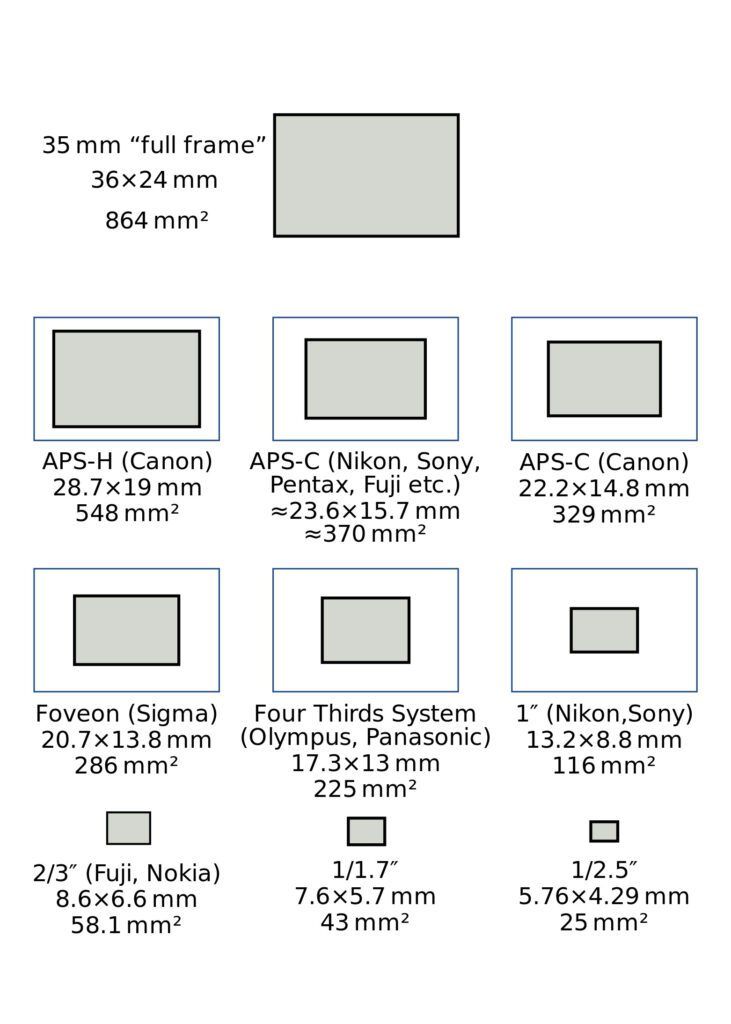
This illustration depicts the ‘normal’ focal length lens for ten different sensor sizes. The definition of a ‘normal’ lens changes with the size of the capturing media. Illustration by WIKIPEDIA
A “normal” focal length is generally accepted as approximately the length of the diagonal of the frame of the particular format. You can see from the chart that the formats vary, a lot, which is why the “normal” focal length varies a lot. The diagonal of a 36x24mm full-frame camera, film or digital, is 43.3mm; therefore, the “normal” focal length range for a full-frame is around 40 to 50mm. This is where the famed “Nifty-50” comes from. I shoot APS-C, “half-frame” or “crop sensor” 24x18mm that has a diagonal of 27.3mm, so my camera’s “normal” focal length is around 30mm. On a full-frame, a 30mm lens is a mild wide-angle. On a crop sensor, the Nifty-50 is a mild telephoto. Most tiny-sensor point-and-shoots will have a normal focal length around 10mm – a long way from normal on a full-frame, but perfectly suited to the smaller sensor.
Key Lesson: “Normal” focal lengths are relative to the diagonal of the format. Since there are many formats, there are many “normal” focal lengths.
“Normal” focal length lenses have an angle of view, or arc, approximately that which the human eye sees sharply, around ~45°. That excludes peripheral vision, around 180°, that you may think of as the “corner of your eye.” You don’t see sharply beyond about 22° to either side of where you are focused. Your eye instantly adjusts no matter where you look, so what you see is always center-sharp and perceived as a “normal” perspective. That is why the normal focal length is so useful. In the paleophotographic, almost every 35mm camera came with a 50mm normal lens. Some of us, being starving students, had only the normal lens for quite a while. We made do. You can still do a lot with only a normal prime for your format, but it is limiting, which is why even the lowest compacts usually come with at least a 3X optical zoom for some flexibility.
Your typical smartphone camera has a tiny sensor, about the 1/2.5” above. The diagonal of that is 7mm, but most phones have a base focal length around 5mm, a wide-angle relative to the sensor. Now there are phones with multiple cameras, multiple focal lengths, even a couple of optical zooms, plus truly astounding computational photography that does a pretty fair job of mimicking what I shall always think of as “real” cameras.
Recommended Reading: If you’d like to master camera settings to create gorgeous, creamy, blurry backgrounds, grab a copy of Photzy’s premium guide: Beautiful Background Blur.
What Is Equivalent Focal Length?
Most photographers experienced with interchangeable lenses are most familiar with the 36x24mm 35mm film format, what today is popularly called “full-frame.”
On a full-frame camera, a 24mm lens is a wide-angle, and a 100mm lens is a telephoto lens. Now that digital has largely replaced film, various sizes of the sensor also influence the angle of view. What is normal on one format may be wide-angle on another, and the same focal length is a telephoto on a third.
Most photographers experienced with interchangeable lenses are most familiar with the 36x24mm 35mm film format, what today is popularly called “full-frame.”
My Sony APS-C cameras have a 24x18mm frame, exactly half that of a full frame. There were “half-frame” cameras in film. In digital cameras, anything smaller than a full 36×24 frame is called a “crop” frame and has a “crop factor.” My camera’s crop factor is 1.5. If I have a 30mm lens on, or I am zoomed to 30mm, the equivalent or effective focal length is 45mm. One lens that I’ve used here is my Sony FE 70-300mm zoom lens, equivalent to 105–450 in terms of angle of view. On my crop sensors, with their restricted angle of view, the various focal lengths are multiplied by 1.5 to get the equivalents.
It’s important to note that the actual focal length doesn’t change. A 33mm lens on a half-frame does not suddenly become a Nifty-50; it just acts like one.
Key Lesson: “Equivalent” focal lengths almost always relate to the century-old 36x24mm “full-frame” 35mm format.
What Are “Wide Angle” Lenses?
Any focal length that is shorter than the normal focal length for the format can be called a wide-angle. It simply has a wider angle of view, taking in more of the surroundings. Landscape photographers will often reach for a wide angle. They can also be handy in situations where you need the big picture but have no room to back up. Some may suffer from true optical distortions, typically “barrel” distortion where parallel lines appear to bow outward, like a barrel, but these aberrations are usually correctable in post-processing.
What Are “Telephoto” Lenses?
Any focal length that is longer than the normal focal length for the format can be called a telephoto. The word tele- is a big hint, as TELEscopes magnify and appear to bring faraway objects nearer. We often call these “long” lenses. The longer the lens’s focal length, the greater the magnification. Portrait photographers favor lenses that are at least half again the normal focal length because being further from your subject gives a more pleasing perspective, plus longer lenses make it easier to achieve “bokeh” (Japanese for blur) (that blurry background that helps to pop your subject out). Short lenses have less bokeh, and very short lenses seem to have none.
Key Lesson: Wide-angle lenses, called “short” sometimes, have a wider angle of view than normal. Telephotos, “or long,” lenses have a narrower angle of view than normal.
How and Why Does a Photographer Choose a Particular Lens?
Often, the choice of focal length is dictated by the composition. One reason landscape photographers often choose wider angle lenses is to take in more of the scene. Wildlife photographers will couple on something long to bring an animal closer without spooking it or putting themselves in danger. But there is no reason that a landscapist can’t take a gorgeous picture with a telephoto, or a wildlife person can’t get the picture they want with a wide-angle. You choose your focal length to suit the picture.
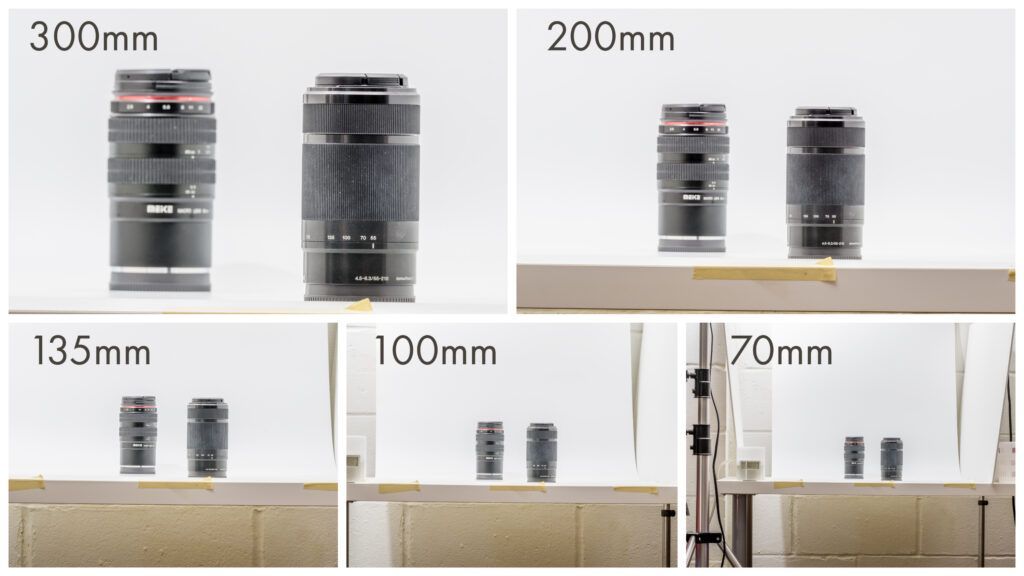
The camera never moved as the focal length was zoomed back. The spatial relationship between the two subjects never changes, only the magnification. Photograph by Charles Haacker
One reason I favor zooms is that I like having multiple focal lengths that I can vary with a twist of the barrel. I shoot a lot of events with two bodies with overlapping zooms, giving me a nearly unlimited range from wide-angle to extreme telephoto. You’ve heard of “zooming with your feet”? That’s fine, but what they don’t tell you is that it changes the perspective, plus doesn’t consider the problem of the subject is far away and maybe there’s a moat in between. I like being able to choose where I want to stand and zoom to get the composition and reach that I want, and my experience is that the image quality (IQ) of modern zooms is superb. Their biggest drawback is that they are bigger, heavier, and slower than primes.
Does Focal Length Affect Perspective?
Key Lesson: Perspective is defined as the appearance of things relative to one another as determined by their distance from the viewer.
So long as the camera never moves, the perspective never changes. Perspective “compression” is an illusion caused by using a telephoto lens. Being able to crop in the camera is a great tool, but the perspective does not change until the camera physically moves.
When I was in school, we did an exercise where we took a series of pictures of objects at some distance from one another, such as these two similar lenses spaced one foot apart (the right-hand lens is closer to the camera).
To prove that the perspective never changed so long as the camera never moved, we enlarged each of the pictures in the previous illustration to match the first one, made with the longest focal length.
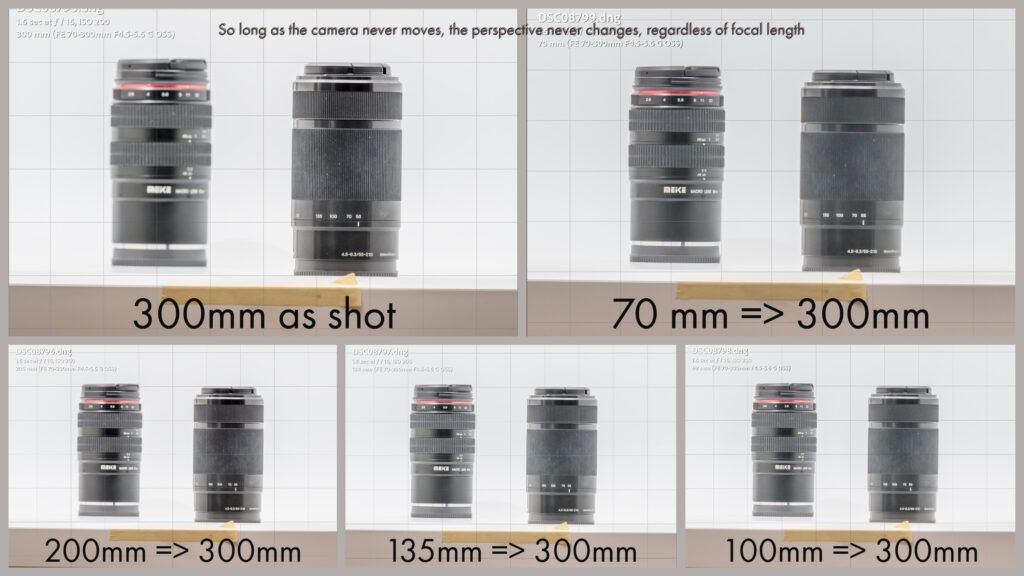
Photograph by Charles Haacker
And here is the proof. The actual 300mm image is the sharpest owing to needing no enlargement. The rest get incrementally less sharp and grainier but show that the spatial relationship among objects never changed as long as the camera position did not change.
The second part of the assignment was to move the camera closer while keeping the nearer object the same size in each frame.
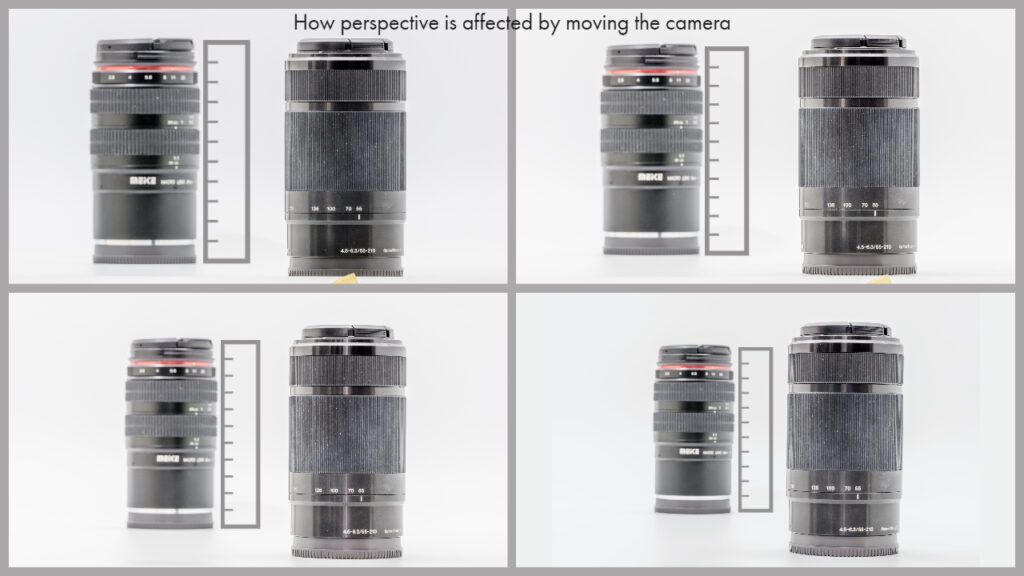
Photograph by Charles Haacker
The top-left frame was shot with the 300mm, showing the two subjects appearing to be about the same length, which they physically are. But the lens on the right is nearer to the camera, and the left-hand one is 12-inches back and slightly offset.

Emphasizing the difference in perspective. The far-right lens shows a little bloat from being much closer to the camera. Photograph by Charles Haacker
Notice what happens as the camera gets closer to the nearer lens: the farther lens appears to be moving further away! It isn’t, but what is happening is that the spatial relationships between the camera and both subjects are changing. As the camera gets closer to the nearer object, the farther one becomes relatively further from the camera; it appears to recede. We know it isn’t moving – only the camera is – but camera movement changes the perspective by changing the spatial relationships. Focal length has nothing to do with it.
Key Lesson: It’s a common misconception that focal length affects perspective, which is actually entirely controlled by the camera position.
Does Focal Length Affect Depth of Field?
Yes. No. Maybe… Sort of.
Four main factors affect depth of field (DOF):
- Aperture or f/stop
- Focal length
- Distance to subject-focused upon
- Sensor size as relates to focal length
You may have noticed that your phone camera seems to have DOF that goes on forever. That is due to its tiny sensor with a 5mm focal length. DOF is illusory. We describe it as the [apparent] sharpness in front of and behind the subject focused upon, but the word apparent gets left out. There is only one two-dimensional plane of critical sharpness.
Being able to crop in the camera is a great tool, but the perspective does not change until the camera physically moves.
If you have good eyesight, wherever you look looks sharp because the eye refocuses instantly. In bright sun your irises “stop down,” increasing DOF. If you look far away, everything looks equally sharp because it is small.
It all hinges on magnification. Shorter focal lengths make pictures that seem overall very sharp because the details are small. Longer focal lengths make the details bigger, so all else being equal, pictures made with longer lenses will show any unsharp-ness more.

Photograph by Charles Haacker
These were shot with my 30mm dedicated macro. On the left, the f/stop (aperture) was f/16 (small hole). On the right, it was f/4, a bigger hole, and a difference of four stops. The smaller the aperture, the greater the apparent DOF and vice-versa. I am focused on a single bud very close to the lens. A 30mm on a crop sensor is a normal lens. What is affecting the DOF here is mainly the aperture. The wider (f/4) has much less DOF than the stopped-down f/16. Which is better is a matter of taste.

Photograph by Charles Haacker
This pair was shot with the same 30mm lens, but both pictures were made at f/11. The DOF difference here was controlled mainly by camera-to-subject distance. I think I shot the closeup of the flower spike first and then backed away to get more in the frame, but forgot to “open up” to a wider aperture. The bokeh is poor so the cluster doesn’t stand out as well as it should.
Key Lesson: Focal length is only one of four factors contributing to the apparent depth of field.
Recommended Reading: If you’d like to master camera settings to create gorgeous, creamy, blurry backgrounds, grab a copy of Photzy’s premium guide: Beautiful Background Blur.
Finally, I hope you have learned something from this guide that you didn’t already know about focal length. Photographers who’ve been doing it for a long time forget that not everyone knows what we know. Knowing how focal length works should help you when deciding what lens to pick.
Self-Check Quiz:
- True or False: Focal length refers to the physical length of the lens barrel.
- True or False: “Long” focal length lenses have a wide angle of view.
- What angle of view does a normal focal length cover?
- What is an Equivalent focal length?
- True or False: Wide angle lenses take in a wider angle of view.
- True or False: Telephoto lenses are essentially telescopes.
- What focal length are you most apt to use for photos of the moon?
- True or False: Differing focal lengths profoundly affect perspective, “lens compression.”
- Does focal length affect the depth of field?
Assignment: Using at least two lenses of different focal lengths, shoot two objects with some distance between them. Do not move the camera.
Move the camera closer to the scene and shoot again.
Upload and compare the frames. Enlarge the first set to see if the perspective changes with enlargement. What happens to the perspective in the second set?

